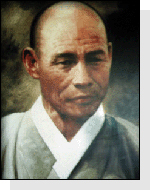- Park In- hwan (1926~1956)
- Park Su- geun (1914~1965)
- Kim Yu- jeong (1908~1937)
- Lee Hyo- seok (pen name Gasan) (1907~1942)
- Kim Dong- myeong (Choheo) (1901~1968)
- Han Yong- un (Buddhist name Manhae) (1897~1944)
- Namgung Eok (pen name Hanseo) (1863~1939)
- Yun Hui- sun (1860~1935)
- Yu In- seok (pen name Uiam) (1842~1915)
- Kim Byeong- yeon (pen name Nango) (1807~1863)
- Nam Gu- man (pen name Yakcheon) (1629~1711)
- Heo Mok (pen name Misu) (1595~1682)
- Heo Gyun (pen name Gyosan) (1569~1618)
- Heo Cho- hui (pen name Nanseolheon) (1563~1589)
- Sinsaimdang (1504~1551)
- Kim Si- seup (pen name Maewoldang) (1434~1493)
- Won Cheon- seok (pen name Ungok) (1330~ ?)
- Lee Seung- hyu (pen name Dongangeosa) (1224~1300)
Han Yong-un (Buddhist name Manhae) (1897~1944)

Hailing from Hongseong, South Chungcheong Province, he was a monk, poet, and independence fighter.
He was among the 33 patriotic independence fighters who represented the nation. His Buddhistname was
Yong-un with another Buddhist alias being Manhae. His ancestors came from Cheongju.
In 1905, he attained Nirvana at Baekdamsa temple, received commandments of Buddhism, and trained himself to be a Buddhist priest. In 1907, he was devoted to practicing Zen at Geonbongsa temple in Goseong.
In 1910, he wrote a Buddhism book titled Joseon-bulgyo-yusinnon at Baekdamsa. When he, as a representative of the nation, led chanting ‘Hurrah for independence’ on the occasion of the March 1 Independence Movement rally in 1919, he was arrested. While imprisoned, he wrote a statement for Korea´s independence, and proclaimed its justification across the world.
In October 1925, he finished writing 88 poems. The work is titled Nimui-chimmuk (Lover´s silence) and pointed to a new turnaround in our literary history. He is ranked among the national poets.
In 1933, he was married to Yu Suk-won, and built and lived in a house dubbed Simujang at Seongbuk-dong, Seoul, where he published as serial pieces long novels in the Chosun Ilbo,. These were titled Heukpung (black wind), Cheolhyeol-miin (blood and iron beauty), Mangmyeong (short life), etc.
In June 1944, he was stricken with paralysis and entered Nirvana. He was buried at the Manguri cemetery. The government, in memory of his feats, posthumously decorated him with a Republic of Korea Medal, in 1962. He was selected as the cultural person of the month in March 1991 by the Ministry of Culture.
In 1905, he attained Nirvana at Baekdamsa temple, received commandments of Buddhism, and trained himself to be a Buddhist priest. In 1907, he was devoted to practicing Zen at Geonbongsa temple in Goseong.
In 1910, he wrote a Buddhism book titled Joseon-bulgyo-yusinnon at Baekdamsa. When he, as a representative of the nation, led chanting ‘Hurrah for independence’ on the occasion of the March 1 Independence Movement rally in 1919, he was arrested. While imprisoned, he wrote a statement for Korea´s independence, and proclaimed its justification across the world.
In October 1925, he finished writing 88 poems. The work is titled Nimui-chimmuk (Lover´s silence) and pointed to a new turnaround in our literary history. He is ranked among the national poets.
In 1933, he was married to Yu Suk-won, and built and lived in a house dubbed Simujang at Seongbuk-dong, Seoul, where he published as serial pieces long novels in the Chosun Ilbo,. These were titled Heukpung (black wind), Cheolhyeol-miin (blood and iron beauty), Mangmyeong (short life), etc.
In June 1944, he was stricken with paralysis and entered Nirvana. He was buried at the Manguri cemetery. The government, in memory of his feats, posthumously decorated him with a Republic of Korea Medal, in 1962. He was selected as the cultural person of the month in March 1991 by the Ministry of Culture.
최근 업데이트 2023-01-10


